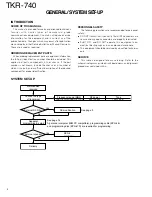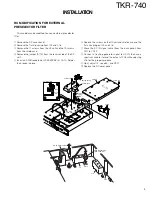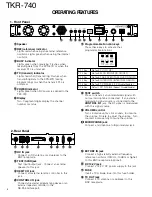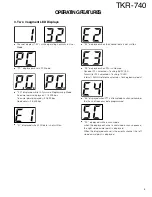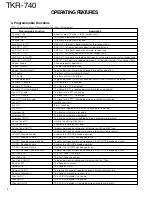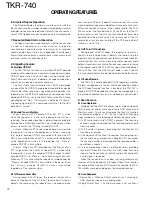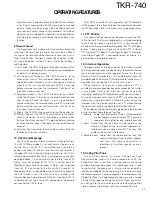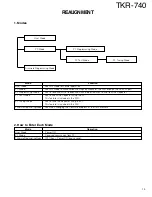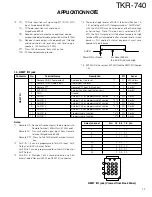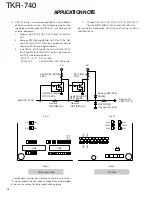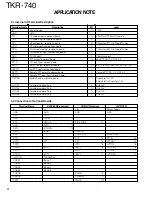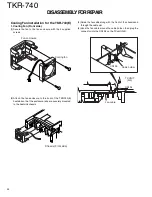
TKR-740
10
OPERATING FEATURES
6. Simplex/ Duplex Operation
The Simplex/Duplex function is used to specify whether
the channel is used as simplex (receiver muted during transmit)
or duplex (receiver unmuted during transmit). The channel has
same TX/RX frequency and can operate only in Simplex mode.
7. Repeater/ Base Station Operation
The Repeat function is used to specify whether the channel
is used as a repeater or as a base station. A repeater
simultaneously and automatically re-transmits its received
audio; a duplex base station has independent simultaneous
transmit and receive paths; a simplex base station are mutually
exclusive transmit and receive paths.
8. Signalling Feature
8.1 Multiple QT/ DQT
The TKR-740 can function as a multiple-QT/DQT decode/
encode unit for operation as a community repeater or multiple-
QT/DQT base station. 16 Multi Tables can be created, each
Multi Table consisting of 16 decode / encode combinations
and can be assigned on a per-channel basis.
The Multi Table function enables the TKR-740 to decode
any one of the 16 QT/DQTs pre-programmed into the selected
Multi Table. When receiving a signal (repeater operation), the
repeater uses the QT/DQT encode which corresponds to the
decoded QT/DQT as set in the Multi Table. In the Multi Table,
signalling pair of
“
No.1
”
(first column) is defined as
“
Primary
”
.
A receiving signalling (if it is contained within No.1 to No.16) is
defined as
“
Current
”
.
8.2 Encode Tone in Multiple
When Local mic PTT, Remote PTT or Ext. PTT is active
while the repeater is in use or the duplex-base station is
receiving, the encode signalling is determined according to
Encode Tone in Multiple function. The simplex-base station
always transmits the
“
Primary
”
encode QT/DQT.
Current : When any PTT as described above is active while
the repeater is in use or the duplex-base station is receiving,
the
“
paired
”
encode QT/DQT associated with receiving QT/
DQT is transmitted. When any PTT is active while the repeater
or the duplex-base station is in idle period, the
“
Primary
”
encode QT/DQT is transmitted.
Primary : When any PTT (provided that the Priority of any
PTT is higher than the Priority of Repeat PTT) is active while
the repeater is in use, the encode QT/DQT changes
“
paired
”
encode QT/DQT to
“
Primary
”
while continuing to transmit.
When any PTT is active while the repeater is in idle period, the
“
Primary
”
encode QT/DQT is transmitted. In the base station,
the
“
Primary
”
encode QT/DQT is always transmitted
regardless of the receiver status.
8.3 QT Reverse Burst Time
During repeat with QT tones, the repeater re-transmits a
phase-shifted burst of the QT tone (
“
reverse burst
”
) when it
detects the radio using the repeater has un-keyed and also
sent a reverse QT burst (squelch-tail elimination). This mutes
a receiving radio
’
s speaker audio before its receiver circuit shuts
off causes squelch tail noise in the speaker audio. The TKR-
740 can select the time between 140 to 200 ms that the QT
reverse burst is sent. Typically this time should not have to be
adjusted from the default value. The transmission of the QT
reverse burst can be also inhibited if the QT Reverse Burst
function is set to
“
No
”
.
8.4 DQT Turn Off Code Time
During repeat with DQT codes, the repeater re-transmits a
specific turn-off code when it detects the radio using the
repeater has un-keyed and also sent the turn-off code (squelch-
tail elimination). This mutes a receiving radio
’
s speaker audio
before its receiver circuit shuts off and causes squelch tail noise
in the speaker audio. The TKR-740 can select the time between
140 to 200 ms that the DQT turn-off code is sent. Typically
this time should not have to be adjusted from the default value.
8.5 Off Hook Decode
The TKR-740 is able to decode QT/DQT regardless whether
the local microphone is in the on- or off-hook condition. When
the Off Hook Decode function is enabled, the TKR-740 is
capable of QT/DQT decode even though the microphone is in
the off-hook condition (or a local microphone is not installed).
9. Scan Feature
9.1 Scan Operation
Providing that the TKR-740 contains two or more non-priority
ADD channel or one or more non-priority ADD channel and
Priority channel, it starts scanning once the Scan On function
is executed and displays
“
SC
”
on the 7-seg LED. Scanning
stops temporarily if any following conditions become valid.
1) if a RF carrier and a valid QT/DQT is present. The receiving
channel number is displayed and the received audio is heard
from a speaker.
2) if a RF carrier is present, providing that the Monitor On
function is executed.
3) if the Squelch Off function is executed. Scanning stops on
the channel being scanned when Squelch Off is executed,
the channel number is displayed and the received audio is
heard from a speaker.
4) if a local microphone
’
s hook is in off hook status, providing
that the Off Hook Scan function is set to Disable. Scanning
stops on the Revert channel, but the audio is not heard until
a valid signal is received.
When the received call is ended, scanning automatically
resumes after the period set in Dropout Delay Time function
has expired. When the Scan Off function is executed, the TKR-
740 inhibits scanning and displays the selected channel.
9.2 Scan Sequence
1) Normal Scan : When no Priority channel is set, scanning of
ADD channels is done in ascending order.
2) Single Priority Scan : The Priority channel is set as either a
Summary of Contents for TKR-740
Page 97: ...TKR 740 TKR 740 BLOCKDIAGRAM 121 122 ...
Page 99: ...TKR 740 TKR 740 INTERCONNECTION DIAGRAM 125 126 ...
Page 101: ...MEMO 129 ...


